If someone told me I could only take pictures of one thing for the rest of my life - I'd think about it for awhile, and then choose lightning. Luckily I live in reality and no one will ever say that to me, but it does speak to how passionate I am about photographing this stuff.
I'm a storm chaser at heart, so I love everything about weather. It would be difficult if I couldn't also capture awesome dust storms, supercells, flash floods and whatever else might happen out there. But lightning - I love lightning.
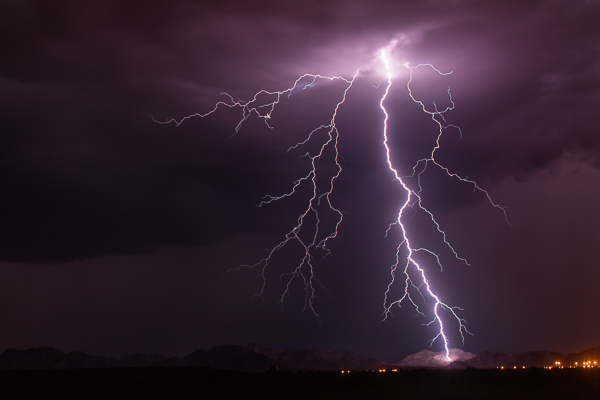
"MountainSide" - Buckeye, Arizona - 50mm, ISO 100, f/8.0, 20 sec
The Adrenaline Rush
What is it about lightning? I've lived in Arizona my entire life and I grew up loving our summer monsoon season. One of my early memories as a kid was sitting on our back porch with my dad and being blinded by a strike hitting the field behind our house. I still remember being blinded for a few seconds. It was that close and that intense.
Arizona is a fantastic venue to capture lightning. We get a lot of high-based storms, which means you tend to see more of the strike. Our landscape is beautiful, from deserts and cacti, to rolling grasslands and the Grand Canyon. I once met a guy in Tucson who was spending two whole weeks in Arizona solely to photograph lightning, and he was from Germany!
Trying to capture lightning is an adrenaline rush. It's addicting. You can look at the back of your camera and know you just caught an epic bolt, but still not be satisfied, or maybe that's just me. It's never enough. I want more. More and more.
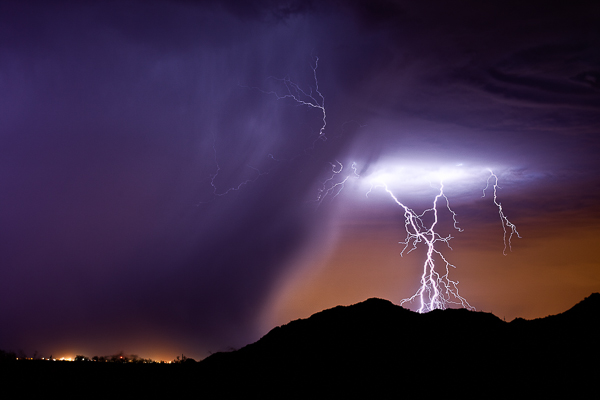
"Purple Rain" - Highway 347, AZ 50mm, ISO 200, f/6.3, 25 sec
Lightning is freaky. You want to get close, but not too close. The closer the better - sometimes. Suddenly it gets quiet and you realize a storm just built up right over your head and a strike from nowhere makes you double-check your shorts. I am usually out in the middle of nowhere, late at night, and there is something crazy spooky about seeing an entire landscape get lit up in the blink of an eye.
What makes lightning fun to photograph is the uniqueness of it all. No two bolts are the same. You never know what you'll end up with. Plus, if you are all alone out there, no one else can have the same image as you do.
Finding the Storms
This is in reality the hardest part of photographing lightning. You may worry about your settings and lenses and all that, but if you do this for a while, that all becomes second nature. Finding the storms is the difficult task. You may live in a part of the United States, or even the world, where lightning just doesn't happen much, if at all. But if it does, then you have to learn the patterns and watch the forecasts to be prepared.
The best way to do that here in the U.S. is to bookmark the webpage of your local National Weather Service, which you can find on NOAA.gov. Their pages have links to radars where you can track the storms. If you want to really get intense, grab a copy of RadarScope (iOS or Android) to have it on your Smartphone anytime you want.
If you don't have lightning in your area, you may want to invest in a storm chasing tour, or vacation somewhere like Arizona during the summer.
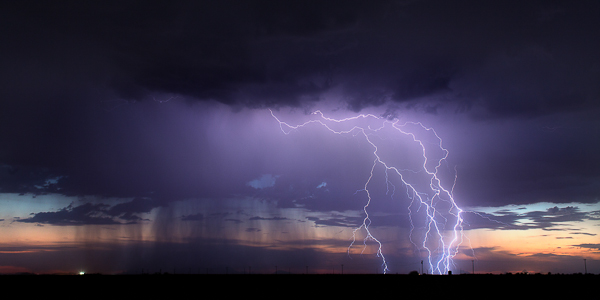
"Buckeye" - Buckeye, AZ - 50mm, ISO 160, f/10, 8 sec
Tools You Need
Okay, these next few sections are what you really care about anyways, so let's get to it. Tools, meaning things you need to capture lightning.
The fact is, I started out with a little point and shoot that took three shots per second. I actually caught a crazy strike with it on my third or fourth time out, and that's what really got me hooked. So you can literally capture lighting with basic cameras if you want to depend on luck. There are even apps for your Smartphone.
But if you want to eliminate as much luck as you can AND capture mind-blowing, jaw dropping images - you'll likely want to upgrade your tools. You don't have to go crazy though. Here's the basic list of what you need:
- A DSLR, SLR or any camera that lets you control the length of your exposure.
- Lenses of course. Varying focal ranges are a must, although I'm a fan of primes.
- A tripod - the sturdier the better.
- A wireless shutter release or intervalometer.
That's really the essentials. You don't need the most expensive equipment either. Basic DSLRs are a good starting point. My first upgrade from the point and shoot was a Canon Rebel XSi. It did the job for about a year, but I knew I wanted to go full frame eventually.
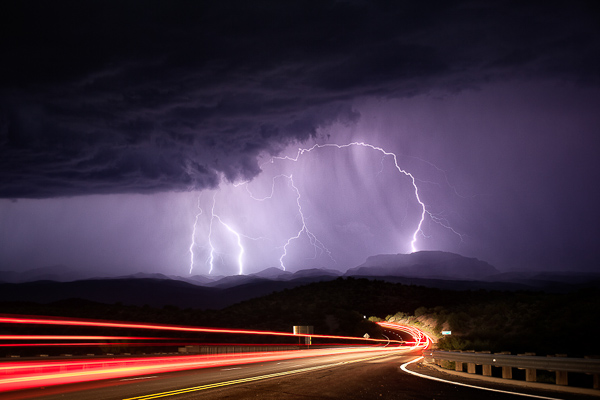
Mammoth, AZ - 50mm, ISO 200, f/6.3, 25 sec
I use Canon products, specifically a couple of 5D Mark III's and a Mark II as a backup. The lenses I carry on a storm chase:
- Rokinon 14mm f/2.8 (mostly for time-lapse photograph, but also for big landscape shots)
- Canon 16-35mm f/2.8
- Canon 17-40mm f/4.0
- Canon 35mm f/1.4
- Canon 50mm f/1.2
- Canon 135mm f/2.0
Your tripod just needs to sturdy and heavy duty. When you are shooting during a thunderstorm there will usually be wind issues. I've had tripods get blown right over by a strong gust of wind. I haven't spent as much on tripods as I do on camera gear and time-lapse tools, but I use Manfrotto legs and heads. If you can afford it, upgrade to a tripod that has independent legs and a steadier base, that will allow you to shoot with a wider stance.
Finally, you will need some kind of external shutter release. It can be anywhere from your basic wired cable release, all the way up to a wireless intervalometer. I personally like the wireless intervalometers because you can control your camera from inside the car where you are safer than standing outside during a lightning storm. I also love the wireless ones because the cabled ones can get tangled in your tripod legs if you are packing up in a hurry. They are are just easier to use.
A Little About Lightning Triggers
Another external control for lightning photography is a lightning trigger. The brilliance of one of these triggers is that it senses the flash of lightning and automatically fires the shutter on your camera. You can comfortably put it on your camera, day or night, and sit back in your car and let the trigger do all the work.
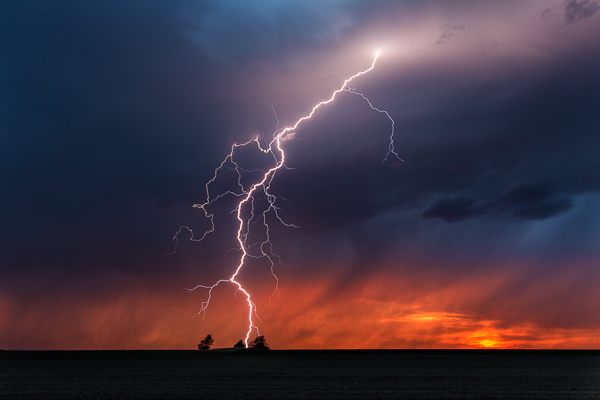
Scott City, KS - 33mm, ISO 100, f/16, 2 sec, lightning trigger
The tough part about lightning triggers is finding one that is reliable. I've had three different ones and it took until I bought one of the most expensive (The Lightning Trigger IV) for me to feel like I found one that works. I've had a few of the $100-200 variety and they don't always trigger from a flash of lightning. That's kind of the point right? So to me, if you can save up for a good one, it's worth the price instead of spending $100 two or three times trying to find one that works.
My opinion on lightning triggers is that they are good during the day, but become less useful the darker it gets. Most photographers like to use a trigger because it helps for shooting daytime lightning, and it also saves your shutter. During the day, you could either take a ton of photos in a row and hope to get lucky, or you could use a trigger. The triggers works then. Great invention.

Red Rock, AZ - 17mm, ISO 400, f/8.0, 1/160th, lightning trigger
There is also an argument that it can save your shutter at night too. But whenever I'm out shooting lightning, there is enough flashing going on that my trigger is going to keep firing over and over anyways. The anatomy of a lightning bolt is that there are parts of it that could be missed if you wait for a trigger to fire your shutter. I'd much rather increase my odds of a capturing the entire lightning bolt by doing 15-25 one second exposures over and over. Once the sun goes down and I can start getting two or three second exposures, I take off the trigger and use the intervalometer. But that's just me!

Tucson, AZ - 14mm, ISO 50, f/16, 2 sec, time-lapse capture
During the day, since I love to do time-lapse, I'll actually get lucky enough to capture bolts just from that, without a trigger. Taking shots every one or two seconds allows you to record a sweet time-lapse and also hopefully snag a few lightning strikes. This has happened to me countless times. I've even captured a few with an even longer interval on the time-lapse. You might give it a try if you are interested in time-lapse at all.
Camera Settings
People ask me all the time "What are good settings for taking lightning photos?" and the answer is that it varies just like anything else in photography. But there are some good guidelines to get you started.
For daytime lightning, you want to do your best to to have as slow of an exposure as you can, which might mean f/16-f/22 and maybe a neutral density filter. I personally don't like ND filters for this kind of photography because when I've used them in the past, they tend to wash out the lightning a little, but it's something to at least try. You might slap an ND filter on, increase the ISO to 200, and hope that helps the bolt show up a bit more intensely. Daytime lightning is tough regardless. The best results are usually when it's really dark with heavy clouds, without much sunlight. The strikes are going to show up a lot better against a dark background.
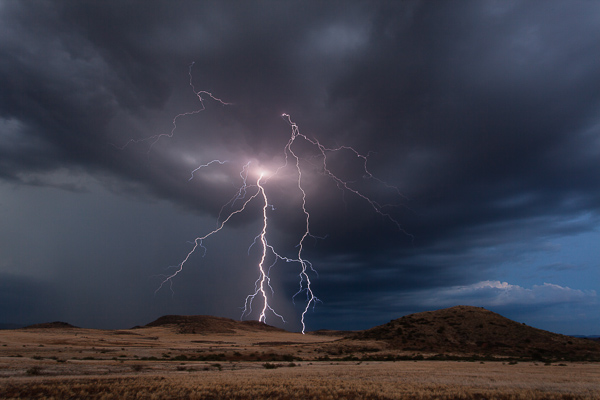
Camp Verde, AZ - 23mm, ISO 100, f/18, 6 sec
Nighttime is a whole different ballgame. There are lots of things that can alter your settings. Are you in the city? Complete and utter darkness? Is there a full moon? Are the bolts coming in fast and furious, or spaced minutes apart? Is the lightning a only a few miles, or 25 or more mile away?
Here are some situations and common settings to use as the sky darkens on a night out chasing storms:
- Dusk/sunset: f/10-16, 2-10 seconds, ISO 200. You might raise your ISO even more because the sky still has some light in it and you want the lightning to really stand out.
- Blue hour - as it gets darker, you will open up your aperture and maybe increase your shutter speed.
- Once it gets dark, your ISO becomes more important. The lightning flash against a dark sky means you don't need as high of an ISO or you risk blowing out your bolt.
- After dark in the city - narrower aperture yields better results with city lights, so you might be shooting at f/10-16 even after dark. The shutter speed would depend on how bright the lights are; same with the ISO. Usually in the city I like 10-15 second exposures.
- After dark, away from light - wider apertures - typically f/5.6-f/8. You'll want to drop your ISO to 100 to make sure you don't have blown out shots. If it's really dark, you may want longer exposures, 20-30 seconds.
- After dark, but lots of ambient light, for example, a full moon - shorter exposures to reduce motion in the clouds if you don't want that.
- Close lightning - narrower aperture, low ISO.
- Far away - varied aperture, maybe higher ISO so the bolts show up better.
The bottom line is none of this is set in stone. You have to get out there and practice to learn the best settings for you and what you like.
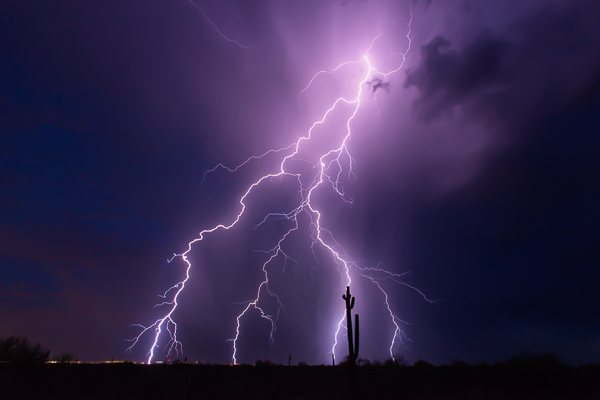
"Saguaro Bolt" - Wickenburg, AZ - 16mm, ISO 200, f/11, 10 sec
The Biggest Things to Watch for:
Don't blow out your lightning. Sometimes bolts are so bright that there is nothing you can do about it. But when you realize the strikes are so intense that you are blowing stuff out, narrow your aperture or drop the ISO.
Don't let your lightning be too dark. Ah the other side of the coin. If your aperture is too narrow and your ISO too low, that distant lightning may not be so bright and vivid. It will require a lot of post-production, and might result in excess noise if you have to increase your exposure to make it look good. You are also probably not going to get a lot of the surrounding clouds and landscapes unless the bolt is very bright. You want to make sure you still have a good exposure so you get details in the clouds and landscape if you can.
Cloud ghosting. If you are taking really long exposures for lightning (25 seconds or longer), you will risk seeing ghosting in your clouds as they get illuminated by different strikes over the course of your shot.
Focusing
I could have included focusing in the above section, but I find it so important that I wanted to put extra emphasis on it. The biggest, most common mistake I see in lightning photography is out of focus images (close second is blown-out lightning). This seems to be the toughest thing to learn how to do correctly.
I include myself in that! Even this past summer I was excited about some lightning images only to get home and realize they were out of focus. We all mess this up.
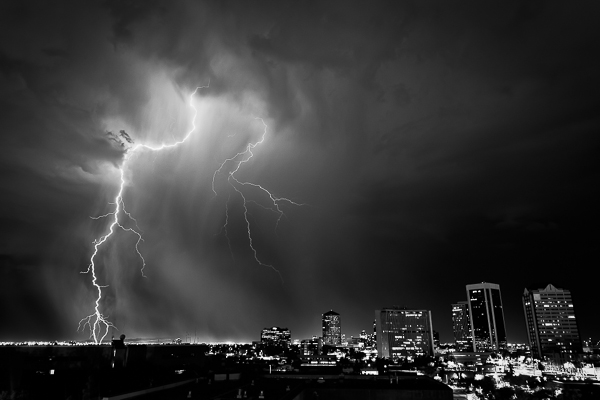
Phoenix, AZ, ISO 200, 26mm, f/8.0, 15 sec
I think the biggest reason for this is that ofter we rely on the "infinity" setting on our lenses. While some lenses have a hard stop for infinity (I am definitely not well versed in many lenses other than Canon), most of them don't. Even if it does have a hard stop, is that actually perfect?
The best way to focus at night:
- Autofocus on distant city lights if you can. I find this to be the most reliable way at night. Sometimes the moon is out which is another good way.
- If there aren't enough lights to focus on, then Live View is your next best method. Use Live View, zoom in (on the screen only not with your lens) to anything you can - even if it's a single light on the horizon, and manually focus on it.
- If all else fails, use infinity. But once you get a lighting strike on camera, check to see if it's in focus. If not, adjust.
Remember, the wider your aperture (like f/5.6), the tougher the focusing. For example, you could focus on lights that are only a mile away, but the bolt lands five miles away and it might be slightly soft. A narrower aperture really does help with this issue. Once for me, it was so completely dark, I chose to focus on an incoming truck's lights about a half mile down the road. Turns out, the lightning 10 miles away was out of focus. I cried - a little.
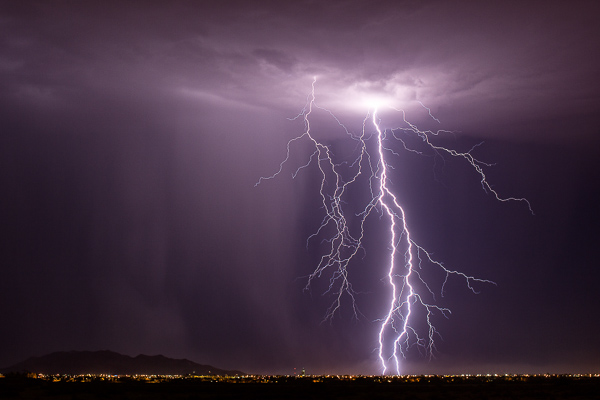
Casa Grande, AZ - 50mm, ISO 125, f/9.0, 25 sec
Another tip, which I've never done myself, is that when you find that perfect infinity spot at say f/8-f/10, put a little scratch on your lens with an X-Acto knife, or a thin line with a paint pen, and just line it up whenever you need it.
Last but definitely not least - if you don't have back button focus set up on your camera, then you will need to set your lens to manual focus. You don't want to go through all the work of focusing on distant lights with Live View, only to take your first shot and have your camera try and focus in the dark! Your absolute best solution here to is look up back button focus on dPS. From landscape to wedding and portrait photographers, this is a must.
Practice, Stay Safe and Have Fun!
All my advice is based on my experience. You may find different opinions or thoughts elsewhere, or you might even have your own methods. That's okay. Figuring out what works best for you is how photography works in general.
The best advice I can give you though, is to practice. You may not have much lightning where you are, so perhaps plan a trip somewhere (like Arizona) where you can spend a few weeks just shooting lightning every chance you get.
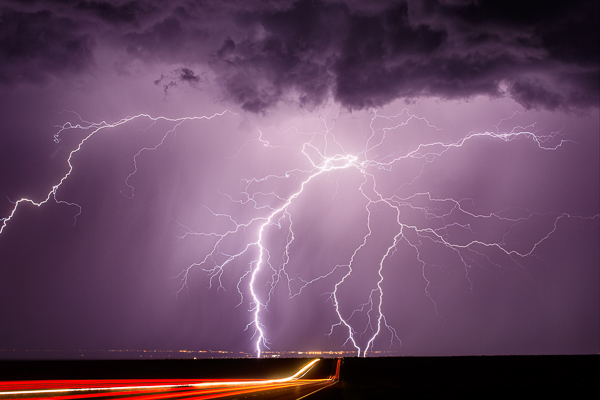
Whetstone - (Highway 90 near Whetstone, AZ 50mm, ISO 100, f/5.6, 25 sec)
Like anything in life, practice makes you better. You can read this article and totally have a good idea of what to do, but actually being out there, in the moment, is a different story. I've done this enough that I can pull up to a spot and pretty much know my settings before I pull the camera out of the bag. But there are still times when I'm not quite sure and need to take a few practice shots. Not all situations are the same, so you will slowly learn the right settings for each scene.
Please stay safe! In the last three months, I've had lightning strikes hit within 75 feet of me. Yikes. It's scary for sure. Do this knowing the closer you get, the more risk you run of getting hit. Two storm chasers have been struck by lightning this year. It's a real danger.
But have fun. There is nothing like capturing an amazing strike on camera. I wish you the best of luck.
The post How to Photograph Lightning - the Ultimate Guide by Mike Olbinski appeared first on Digital Photography School.
No comments:
Post a Comment